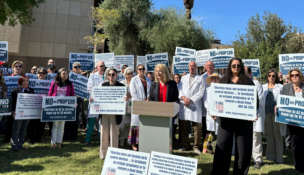Attorneys hope to expand gay partner benefits for state workers
Howard Fischer, Capitol Media Services//October 6, 2014//[read_meter]
Attorneys hope to expand gay partner benefits for state workers
Howard Fischer, Capitol Media Services//October 6, 2014//[read_meter]
 Having won benefits for current partners of gay state and university employees, attorneys are back in court demanding the same for everyone hired in the future.
Having won benefits for current partners of gay state and university employees, attorneys are back in court demanding the same for everyone hired in the future.
And if they win, count on them to start going after cities, counties, school districts and all government employers in Arizona.
Tara Borelli of Lambda Legal Defense and Education Fund wants U.S. District Court Judge John Sedwick to permanently void a 2009 Arizona law which says benefits like health insurance are available only to those who are married. Borelli, the lead counsel on the case, said gay employees need benefits for their partners and children just the same as those who are married.
But Assistant Attorney General Charles Grube, in his own legal filings, effectively is urging Sedwick to butt out.
“Domestic partner health coverage is not a fundamental right,” he told the judge.
He said that means state lawmakers were free to decide to pass a law saying that benefits are limited to those who are wed. Grube said that is a financial decision well within the powers of legislators.
More to the point, Grube said because the state provides no benefits for any unmarried partners, gay and straight, there is no discrimination against anyone because of sexual orientation.
But Borelli said that ignores one key fact: Straight couples have the option to get those benefits by marrying. A 2008 voter-approved state constitutional amendment denies that same right to gays, thereby making those same benefits inaccessible.
And that remains the case in Arizona unless and until federal courts rule gays can wed.
For her own part, Gov. Jan Brewer is defending the law as one based not on sexual orientation but on budget considerations. She told Capitol Media Services the state needed the money it was spending providing benefits to the partners of its gay workers – benefits Sedwick blocked her from cutting.
Borelli, however, said the effects are minimal, saying gays make up just 0.2 percent of all state employees getting benefits.
Arizona first provided domestic partner benefits in 2008 when then-Gov. Janet Napolitano ordered state personnel rules rewritten to expand the definition of who is a “dependent” for purposes of getting benefits. Those rules, which did not specify the gender of the partner, required a showing of financial interdependence and an affidavit by the worker affirming there is a domestic partnership.
But in 2009, after Napolitano resigned to take a post in the Obama administration, the Republican-controlled Legislature approved, and Brewer signed, a state law narrowing the definition – and specifically excluding unmarried couples.
Sedwick issued a preliminary injunction blocking the change, at least as it applies to gay employees.
The judge acknowledged the change in law, tucked into a provision of the state budget, is not discriminatory on its face. But he said the denial has to be examined in light of the ban on same-sex marriage.
“As a result, (the law) denies lesbian and gay state employees in qualifying domestic partnership a valuable form of compensation on the basis of sexual orientation,” he wrote in 2010.
Sedwick has since given the case class-action status. That sets the stage for the fight over whether the law should be permanently blocked.
Grube told the judge there’s no basis for such an order. He said any disparate impact on gays is the result not of this law but of the other statutes and constitutional provisions which bar gays from marrying.
On a more practical level, Brewer said there’s the question of cost.
“I think we all know that Arizona was in dire shape financially,” she said of her 2009 decision to sign the law voiding the change in rules.
“We had to make some tough choices,” the governor continued. “I believe that was one area we could cut costs, just like we had to do in behavioral health or education.”
Borelli, however, gave Sedwick figures – produced by the state – which show the cost of benefits for the partners of gay workers now covered is less than 0.3 percent of the total program, with the cost of claims for children at about 0.01 percent.
Brewer also brushed aside questions of whether the state should reconsider now that its finances are vastly improved from 2009.
“I would tell you that, almost today, no one can afford insurance,” saying that is a question that can be taken up by the next governor and the next crop of legislators.
Finances aside, Grube said there’s a rational reason for lawmakers providing benefits to those who are married versus those who are not.
“Under Arizona law, married persons have a legal duty to supply support to their spouses,” he told the judge.
“A married person who fails to provide a spouse with necessary medical attendance actually commits a crime,” Grube continued. “There is no such criminal statute for unmarried persons.”
But Borelli noted it is the state itself that prohibits gays from marrying in the first place and being subject to laws governing marriage. Beyond that, she said this is not a matter of criminal law.
“Plaintiffs rely on family coverage as an important part of their compensation for the same reason as their heterosexual colleagues: to provide shelter and protection to their families from the potential extreme stress of untreated illnesses and attendant financial burdens,” she wrote.
And that, she said, goes to the other part of her discrimination argument. She said the gay workers are doing the same job as their heterosexual counterparts.
Brewer had one more reason to justify the Arizona law.
“The federal government also does not provide insurance to domestic partners,” she said.
Borelli said that’s true. But she also said it’s unnecessary since the federal government recognizes the marriages performed in states where that is legal, allowing gay employees to get benefits for their partners.
It is only in states like Arizona, she said, where that is an issue.

















